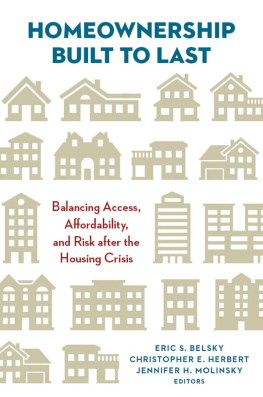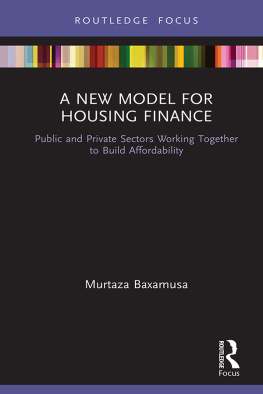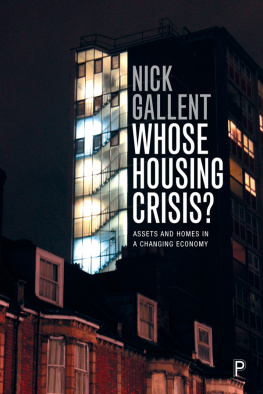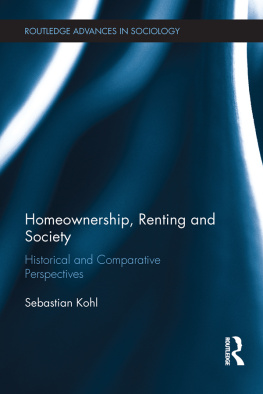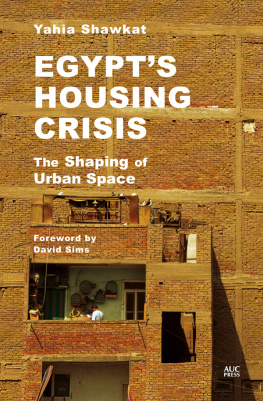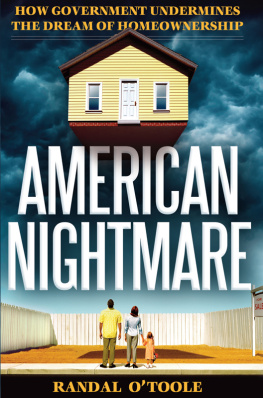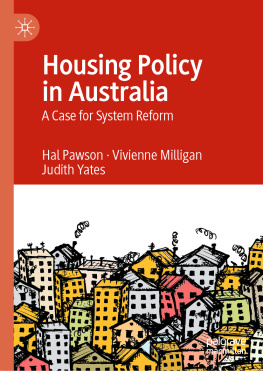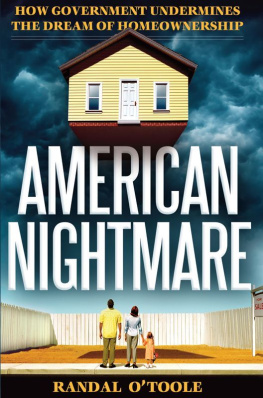HOMEOWNERSHIP BUILT TO LAST
Balancing Access, Affordability, and Risk after the Housing Crisis
ERIC S. BELSKY
CHRISTOPHER E. HERBERT
JENNIFER H. MOLINSKY
Editors
JOINT CENTER FOR HOUSING STUDIES
HARVARD UNIVERSITY
Cambridge, Massachusetts
BROOKINGS INSTITUTION PRESS
Washington, D.C.
Copyright 2014
THE BROOKINGS INSTITUTION
1775 Massachusetts Avenue, N.W., Washington, DC 20036.
www.brookings.edu
All rights reserved. No part of this publication may be reproduced or transmitted in any form or by any means without permission in writing from the Brookings Institution Press.
The Brookings Institution is a private nonprofit organization devoted to research, education, and publication on important issues of domestic and foreign policy. Its principal purpose is to bring the highest quality independent research and analysis to bear on current and emerging policy problems. Interpretations or conclusions in Brookings publications should be understood to be solely those of the authors.
Library of Congress Cataloging-in-Publication data
Homeownership built to last : balancing access, affordability, and risk after the housing crisis / Eric S. Belsky, Christopher E. Herbert, and Jennifer H. Molinsky, Editors, Joint Center for Housing Studies, Harvard University, Cambridge, Massachusetts.
pages cm
Includes bibliographical references and index.
ISBN 978-0-8157-2564-0 (pbk. : alk. paper) 1. Home ownershipUnited States.
2. Mortgage loansUnited States. 3. HousingUnited StatesFinance. I. Belsky, Eric S., editor of compilation.
HD7287.82.U6H664 2014
333.33'80973dc23 2014015497
9 8 7 6 5 4 3 2 1
Typeset in Adobe Garamond
Composition by Cynthia Stock
Silver Spring, Maryland
Acknowledgments
A book exploring so important and complex a topic as the sustainability of homeownership in the wake of the housing crisis requires the insights and talents of many. We count ourselves fortunate to have worked with such dedicated and adept authors, funders, advisers, and staff in the process of producing Homeownership Built to Last.
The papers in this volume were originally written for and presented at a symposium convened by the Joint Center for Housing Studies in April 2013. The symposium brought together researchers, policymakers, and industry leaders to reflect on the lessons of the housing crisis for sustaining homeownership for low-income and minority families. We are deeply grateful to the event's funders, the Ford Foundation, NeighborWorks America, and Bank of America Charitable Foundation, for providing the support that enabled us to assemble such an exceptional group of authors and participants. We are especially appreciative of George McCarthy, Jerry Maldonado, and Lisa Davis of Ford for their continued encouragement of Joint Center symposia and their deep commitment to improving understanding of the housing markets and policy in order to improve housing opportunities for low-income people.
We want to offer special thanks to the advisory committee that helped us shape the symposium's content and research questions: Janis Bowdler, Eileen Fitzgerald, Edward Golding, Jerry Maldonado, George McCarthy, Andrew Plepler, Janneke Ratcliffe, and Gordon Whitman. The breadth of their expertise and depth of insights were instrumental in shaping the research agenda. Special thanks go to the contributing authors for their exceptional efforts to draw lessons from the housing and foreclosure crisis. Their chapters offer a fuller understanding of both the value and the pitfalls of homeownership, thoughtfully reconsider the role of government in supporting homeownership, and point the way forward to a better system of assessing and balancing risks and sustaining homeownership for those who have the potential to gain so much from it. We also deeply appreciate the moderators, discussants, speakers, and attendees of the symposium for a very thoughtful and energizing debate about how we move on in the wake of the housing crisis.
We owe a great debt of gratitude to our colleagues and friends at the Joint Center for Housing Studies who supported the symposium, this book, and us with their professionalism, expertise, and good humor. Many thanks go to Pamela Baldwin, Kerry Donahue, Mary Lancaster, Angela Flynn, and Jackie Hernandez for their meticulous work on Homeownership Built to Last, and to all staff who assisted with the symposium and provided research support to papers included in this volume: Elizabeth La Jeunesse, Irene Lew, Ellen Marya, Dan McCue, Rocio Sanchez-Moyano, and Abbe Will. And special thanks go to Nicolas Retsinas, director emeritus of the Joint Center, for his wise counsel and support of the event.
Finally, we offer our deepest gratitude to our spouses, Cynthia, Tracey, and Andy, for their encouragement and support.
INTRODUCTION
Balancing Access, Affordability, and Risk after the Housing Crisis
JENNIFER H. MOLINSKY, ERIC S. BELSKY, AND CHRISTOPHER E. HERBERT
The ups and downs in U.S. homeownership over the last two decades are without precedent. Though the first few years of the millennium brought the highest homeownership rate the nation had ever seen, they were followed by a half decade of devastating foreclosures in which millions saw their hopes of building wealth through homeownership dashed. The costsfinancial, psychological, and socialhave been enormous. Yet even in the aftermath of these dramatic events and despite headlines proclaiming the death of homeownership in the United States, Americans overwhelmingly still aspire to own. And though the downturn took a particularly hard toll on homeowners of color and those with low incomes, many advocates still view access to homeownership as an important part of a strategy to build wealth among historically disadvantaged households.
In spring 2013 the Harvard Joint Center for Housing Studies, with support from the Ford Foundation, NeighborWorks America, and the Bank of America Charitable Foundation, convened a symposium to reexamine the goals of homeownership and its risks and rewards, particularly for low-income and minority households. The event explored the lessons to be learned from the housing crisis and Great Recession and considered how homeownership can be made more sustainable over time to increase the likelihood that its benefits will be realized. The symposium was structured around thought-provoking original research commissioned from leading academics that forms the chapters of this book. It was further enriched by the participation of nearly 100 policymakers, industry leaders, housing advocates, and scholars.
Here we introduce the motivation for the symposium and this book: the housing crisis, the questions that have arisen in its aftermath about the role of low-income homeownership in the housing boom and bust, and the ongoing debate about how the nation moves forward in its homeownership policy. We then draw lessons from the chapters that follow, examining how to achieve the appropriate balance among breadth of access to homeownership, affordability, and limitation of the risks assumed by homeowners, investors, and taxpayers.
The Housing Boom and Bust and Its Aftermath
The past two decades have seen remarkable changes in U.S. homeownership rates. After two decades of stagnation from the 1960s to early 1990s, the national homeownership rate rose to an all-time high of 69.3 percent in 2005, an increase of 5 percentage points since 1994. Rates for minorities climbed more steeply: the homeownership rate for African Americans climbed from 42.8 percent in 1994 to 49.7 percent in 2005; for Hispanics, from 41.6 percent to 49.3 percent; and for Asians, from 51.7 to 60.0 percent. Homeownership expanded among lower-income households as well: from 1994 to 2002, the rate for those with annual incomes of $25,000 or less rose over 5 percentage points from 44.0 percent to 49.7 percent.

